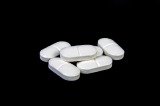
People are flocking to Harvoni, the newest hepatitis C treatment. The most common side effect is headache. Generally, the headaches are mild, and they tend to be worst in the first week of treatment. If headaches are too uncomfortable, people tell me they take ibuprofen. However, acetaminophen (Tylenol) if taken as directed is a better choice. Using aspirin, ibuprofen, and naproxen may cause a rebound headache. This means that the headache will most likely return once the relief wears off.
When I tell people that acetaminophen is better for headaches than ibuprofen, I know what the response will be. “Acetaminophen is toxic to the liver.” Or, “my doctor told me not to take acetaminophen.” To which I want to respond, "Your doctor is misinformed. Yes, acetaminophen can be toxic if taken incorrectly. However, it is a MUCH better choice than ibuprofen, which injures significantly more people even when taken correctly. I’ve been having this conversation with many people for more than 15 years.
The Facts
Approximately 50 million people take acetaminophen every week. Slightly more than 300 people die annually from it. Nearly all of these are from overdose; half are from intentional overdose (suicide attempts). Every day, roughly 30 million people take nonsteroidal anti-inflammatory drugs (NSAIDs) such as ibuprofen, naproxen. The annual death rate ranges from 4000 to 16,500. Causes of death are heart attack, stroke, kidney failure, and bleeding (ulcers).
So, if acetaminophen is safe, how did it get its reputation? Toxicity can occur at just twice the maximum recommended dose of acetaminophen, which is no more than 1000 mgs per dose up to 4000 mgs a day. Who takes that much? You’d be surprised. The problem is that acetaminophen is an ingredient in many medications. Remedies for colds, headaches, pain, sleep, sinus problems, cough and PMS often contain acetaminophen. Lose track of this fact, and you may be taking toxic amounts. Vicodin (acetaminophen and hydrocodone) users who take more than prescribed may find themselves in trouble quickly. One tablet may contain up to 750 mg of acetaminophen, so two Vicodin exceeds the safe limit.
But I Have a Liver Disease - How Can Acetaminophen Be Safe?
Once you’ve been diagnosed with a liver disease such as hepatitis C, many doctors will tell you not to take acetaminophen. However, talk to a hepatologist (a liver specialist), and they will tell you the opposite. When the liver is malfunctioning, it is unable to make clotting factors. NSAIDs increase bleeding risk. Also, cirrhosis is often accompanied by kidney failure, and NSAIDs are a no-no with poor functioning kidneys.
Acetaminophen is used in liver transplant centers. Again, the key is to use it as directed. Here is information provided by the University of Pennsylvania’s Liver Transplant program: Safe Acetaminophen Doses for Liver Transplant Patients.
How to Take Acetaminophen Safely
- Talk to your doctor or nurse about the right dose for you.
- Be sure that your total acetaminophen (APAP) dose includes all sources of this drug. APAP is added to over 600 other medications, including pain meds, sleep meds, cold meds, cough meds, sinus meds, etc. Check here to see if your medication has APAP in it.
- Never take more than 1,000 mgs in a single dose.
- The maximum daily dose for a healthy adult who weighs at least 150 pounds is 4,000 mgs, divided over 24 hours. Although it’s best to take the lowest dose you can, 3,000 mg per day has a clean safety record for adults, which is the dose many liver experts recommend for their patients who don’t have advanced liver disease.
- Reduce your dose to 2000 mg a day if you are a liver transplant patient or if you drink alcohol. No alcohol is advised for those with hepatitis C or other liver diseases. The University of Pennsylvania provides information about safe APAP use for liver transplant patients.
- Start small. A single dose ranges from 325 mg, 500 mg, 650 mg or 1000 mg; some people have good results at the lower doses.








20 Comments
20 Comments